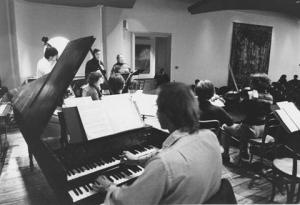- Home
- About
- About SCMS
- Directors
- Artists
- Vera Beths
- Steven Dann
- Marc Destrubé
- James Dunham
- Mark Fewer
- Eric Hoeprich
- Christopher Krueger
- Myron Lutzke
- Marilyn McDonald
- Douglas McNabney
- Mitzi Meyerson
- Pedja Muzijevic
- Anca Nicolau
- Jacques Ogg
- Loretta O'Sullivan
- Lambert Orkis
- Paolo Pandolfo
- William Purvis
- Marc Schachman
- Jaap Schröder
- Andrew Schwartz
- William Sharp
- Ian Swensen
- Lucy van Dael
- Ensembles
- Concerts
- The Collection
- Recordings
- Education
- Donate

James Weaver, then a curator in the Division of Musical Instruments at the National Museum of History and Technology, established the Smithsonian Chamber Players in 1976. The group initially consisted of nine members, soprano Jean Hakes, wind players James Caldwell and Michael Seyfrit, violinists Marilyn McDonald and Mary Price, violist Melissa Graybeal, cellist Kenneth Slowik, bass player Thomas Wolf, and Weaver, who led the group from the harpsichord or fortepiano. From its very inception, the ensemble toured extensively under the auspices of the Smithsonian National Associates, presenting programs of music by Haydn, Mozart, Schubert, Vivaldi, Telemann, and Johann Sebastian, Johann Christian, and Johann Christoph Friedemann Bach.
Over the intervening years, the ensemble’s repertoire expanded in both chronological directions, reaching back into the sixteenth century and ahead to the mid-twentieth, including from 1993-95, the first period-instrument performance of the complete cycle of Brahms’s chamber music. The circle of performers was expanded to include European as well as American specialists, according to the repertoire chosen for a particular concert or recording, always comprising accomplished musicians who shared an expertise in and deep involvement with the music, instruments, and performance practices most appropriate to the works studied. Although SCMS has spawned several other successful ensembles, the Chamber Players remains an integral part of the Smithsonian Institution's pioneering role in the exploration of the rich cultural heritage of American music-making.


